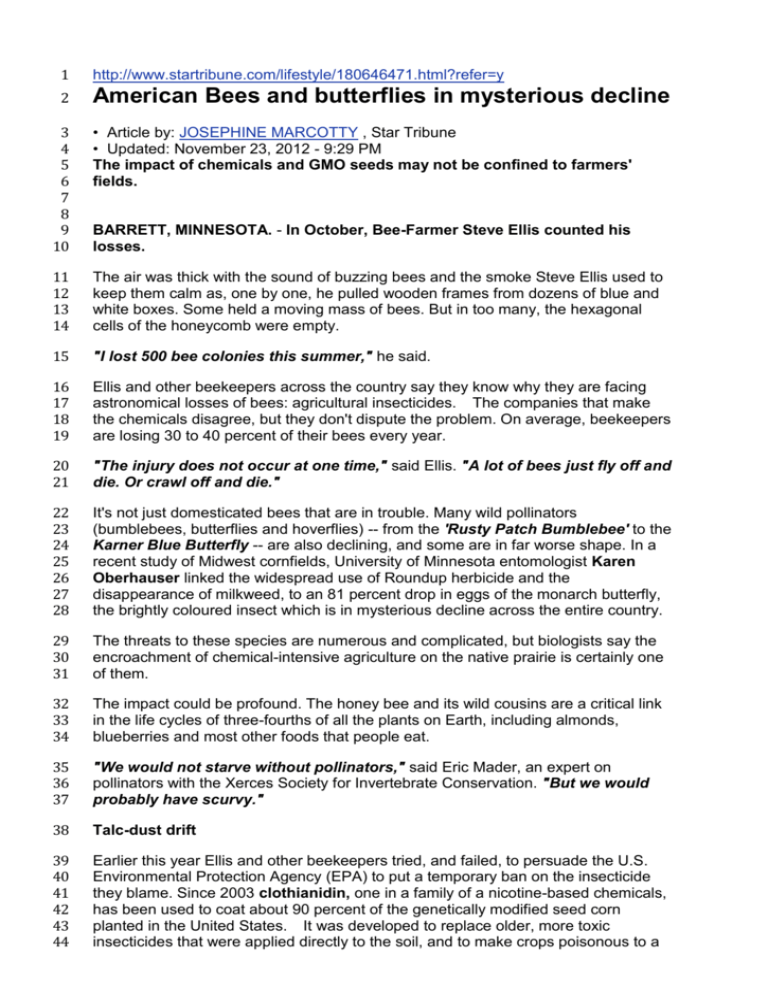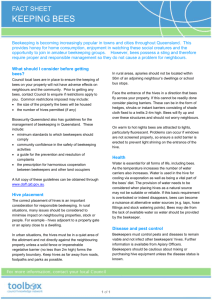the file
advertisement

1 http://www.startribune.com/lifestyle/180646471.html?refer=y 2 American Bees and butterflies in mysterious decline 3 4 5 6 7 8 9 10 • Article by: JOSEPHINE MARCOTTY , Star Tribune • Updated: November 23, 2012 - 9:29 PM The impact of chemicals and GMO seeds may not be confined to farmers' fields. 11 12 13 14 The air was thick with the sound of buzzing bees and the smoke Steve Ellis used to keep them calm as, one by one, he pulled wooden frames from dozens of blue and white boxes. Some held a moving mass of bees. But in too many, the hexagonal cells of the honeycomb were empty. 15 "I lost 500 bee colonies this summer," he said. 16 17 18 19 Ellis and other beekeepers across the country say they know why they are facing astronomical losses of bees: agricultural insecticides. The companies that make the chemicals disagree, but they don't dispute the problem. On average, beekeepers are losing 30 to 40 percent of their bees every year. 20 21 "The injury does not occur at one time," said Ellis. "A lot of bees just fly off and die. Or crawl off and die." 22 23 24 25 26 27 28 It's not just domesticated bees that are in trouble. Many wild pollinators (bumblebees, butterflies and hoverflies) -- from the 'Rusty Patch Bumblebee' to the Karner Blue Butterfly -- are also declining, and some are in far worse shape. In a recent study of Midwest cornfields, University of Minnesota entomologist Karen Oberhauser linked the widespread use of Roundup herbicide and the disappearance of milkweed, to an 81 percent drop in eggs of the monarch butterfly, the brightly coloured insect which is in mysterious decline across the entire country. 29 30 31 The threats to these species are numerous and complicated, but biologists say the encroachment of chemical-intensive agriculture on the native prairie is certainly one of them. 32 33 34 The impact could be profound. The honey bee and its wild cousins are a critical link in the life cycles of three-fourths of all the plants on Earth, including almonds, blueberries and most other foods that people eat. 35 36 37 "We would not starve without pollinators," said Eric Mader, an expert on pollinators with the Xerces Society for Invertebrate Conservation. "But we would probably have scurvy." 38 Talc-dust drift 39 40 41 42 43 44 Earlier this year Ellis and other beekeepers tried, and failed, to persuade the U.S. Environmental Protection Agency (EPA) to put a temporary ban on the insecticide they blame. Since 2003 clothianidin, one in a family of a nicotine-based chemicals, has been used to coat about 90 percent of the genetically modified seed corn planted in the United States. It was developed to replace older, more toxic insecticides that were applied directly to the soil, and to make crops poisonous to a BARRETT, MINNESOTA. - In October, Bee-Farmer Steve Ellis counted his losses. 45 46 wider range of pests. Some view it as more 'environmentally safe' because it is absorbed by the corn as it grows and is contained within the plant. 47 48 49 50 51 Beekeepers say it's having unintended consequences. In the spring, said Ellis, huge machines criss-cross the cornfields where his bees forage. The pesticide coated corn seeds are dusted with talc to make planting more uniform. But the contaminated powder blows across the landscape -- and the flowers that bees pollinate. The bees pick it up on their bodies they bring it back to the hives and their young, Ellis said. 52 53 54 Jack Boyne, an entomologist with the manufacturer Bayer CropScience, said that no studies have found the pesticide in bees or their hives at lethal doses. He said Bayer has studied bees that forage in canola plants treated with clothianidin. 55 56 57 "There was no effect on either the workers, the brood, the fecundity or the honey production," he said. Bees, he said, face other threats, including diseases and the loss of habitat. 58 Still, other scientists and beekeepers say something troubling is happening. 59 "It is an insecticide," Ellis said. 60 61 62 Recently researchers in Indiana found high concentrations of two insecticides in talc blown from corn planters. And they found them on dandelions around farm fields, in pollen stored in hives, and, in non-lethal doses, in the bees from nearby hives. 63 64 65 66 67 Two other studies found that such low-level exposure to the chemicals did have an effect on bees. One, conducted by French researchers, showed that the chemicals confused the bees, making it harder for them to find their way home. The other, by scientists in Britain, found that they keep wild bumblebees from supplying their hives with enough food to produce new queens. 68 69 70 71 The biggest unknown, however, is what happens when those low doses of insecticide are multiplied across tens of millions of acres. Mace Vaughan, a conservationist with the Xerces Society for Invertebrate Conservation, said that, scaled up to the size of the Midwest Corn Belt: "Well, that changes the game." 72 Josephine Marcotty • 612-673-7394






